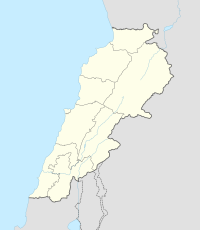Monastery of Saint Maron
| Alternative name | Deir Mar Maroun |
|---|---|
| Location | Beqaa Valley, Lebanon |
| Coordinates | 34°21′00″N 36°22′00″E / 34.35°N 36.366667°E |
| History | |
| Periods | Ancient Rome, Byzantine Empire, Mamluk, Ottoman empire |
| Site notes | |
| Condition | recently cleaned, falling into disrepair |
| Public access | Yes |
| Part of a series on the |
| Maronite Church |
|---|
 |
| Patriarchate |
| Religious orders and societies |
| Communities |
| Languages |
| History |
| Related politics |
|
|
The Monastery of Saint Maron (Syriac: Deir Mar Maroun), also called the Cave of the monks, is an ancient cavern carved out of solid rock in the side of a cliff, located around 200 metres (660 ft) from Ain ez Zarqa, the source of the Orontes river, south of Hermel in Baalbek-Hermel Governorate, northern Lebanon.[1][2][3]
The cavern is situated 90 metres (300 ft) above the river. It consists of three levels with rock stairways, numerous altars, and small cells, suggested to have been the residence of Saint Maron and his early followers in the fourth century CE, during the foundation of the Maronite Church. It is suggested that Maron worked and even died in the monastery. Later occupation in Mamluk and Ottoman empire periods is attested by loopholes cut into the walls.[2][4] The monastery is commonly thought to have been constructed by Romans, however the date, builders and origins of the structure are not certain.[1]
The structure has fallen into disrepair, having been used as shelter for sheep, goats, and the occasional shepherd over the years.[5] The cavern is located on land owned by the Ministry of Energy and Water of Lebanon, but has been the subject of an ongoing dispute between the Maronite Archdiocese and the Dandash family, who stakes an old claim on the land. The Maronite Archdiocese has retained rights to renovate the landmark and has stated intentions to begin a restoration project. The site has only reported to have been cleaned and no work has started on the monument, suggested to be of "national" importance.[1]
References
- ^ a b c al-Fakih, Rakan., Mar Maroun monastery restoration undeterred, The Daily Star (Lebanon, 2012-01-11. (Archived October 14, 2012, at WebCite)
- ^ a b Michel M. Alouf; Tedd St Rain (1999). History of Baalbek. Book Tree. pp. 49–. ISBN 978-1-58509-063-1. Retrieved 15 October 2012.
- ^ Paul Doyle (1 March 2012). Lebanon. Bradt Travel Guides. pp. 215–. ISBN 978-1-84162-370-2. Retrieved 15 October 2012.
- ^ Robert Boulanger (1955). Lebanon. Hachette. Retrieved 15 October 2012.
- ^ Charles William Meredith van de Velde; Carel Willem Meredith Velde (van de) (1854). Narrative of a journey through Syria and Palestine in 1851 and 1852. W. Blackwood and sons. pp. 472–. Retrieved 15 October 2012.
External links
- Deir Mar Maroun on satelliteviews.net
- Caves of "Raheb" on discoverlebanon.com
- Deir Mar Maroun on the Megalithic Portal
- Deir Mar Maroun on ikamalebanon.com
- Deir Mar Maroun Dispute - LBC News on YouTube
- Deir Mar Maroun on middleeast.com
- 3D Google Map of Deir Mar Maroun on gmap3d.com
- Deir Mar Maroun photo
- Deir Mar Maroun photo

